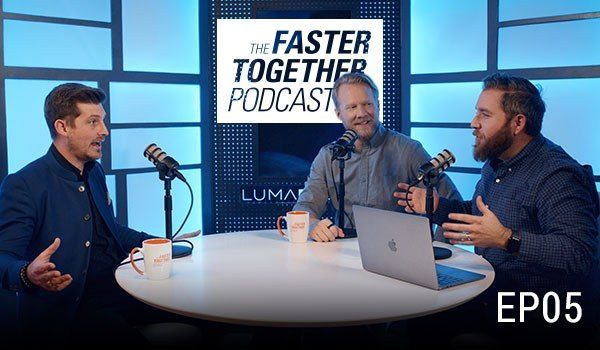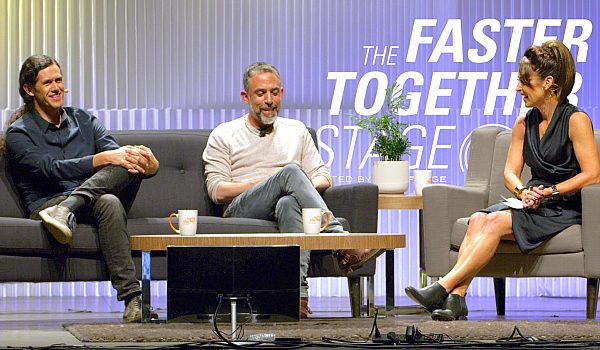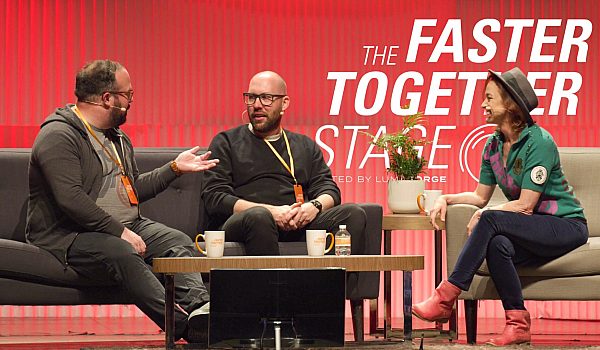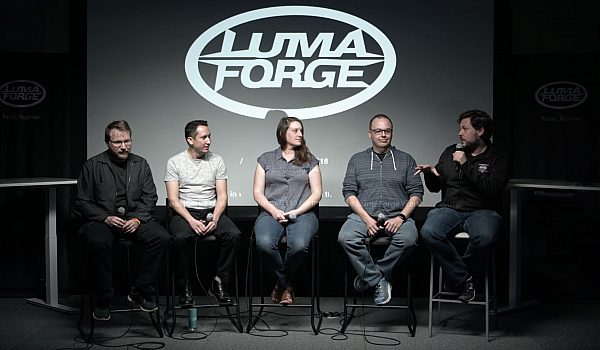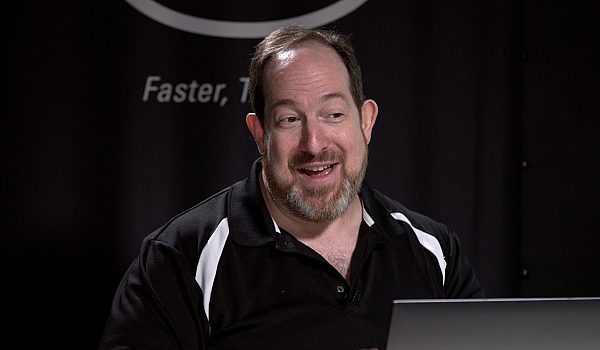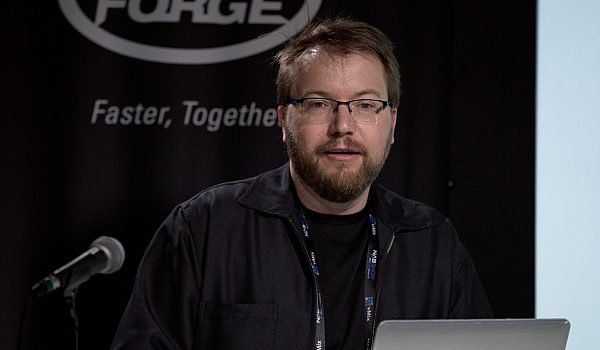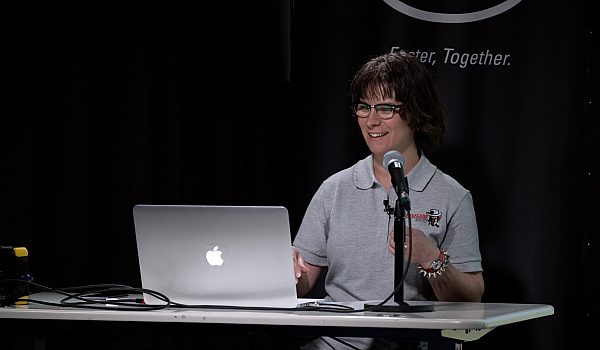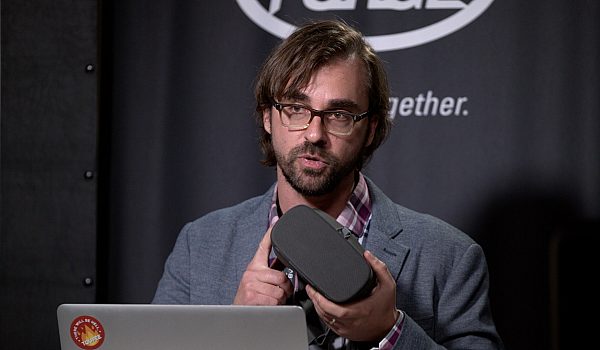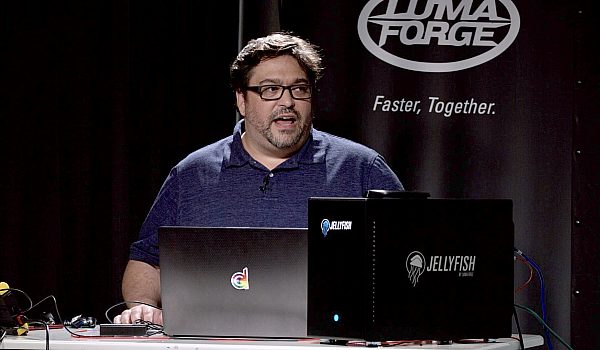Lumberjack Builder enables you to edit your transcripts into a paper cut with ease. Since your transcript is tied to the footage, you can play the paper cut back within Lumberjack Builder. Once you have the desired paper cut, you can send it to Final Cut Pro X as a Project.
The Project inside Final Cut Pro X includes lower thirds for all of your speakers. You get an instant radio cut from your paper cut via FCPXML.
In this presentation, Philip Hodgetts demos Lumberjack Builder. He'll show you how to organize your transcripts, fix timing issues, and send your paper cut to FCPX.
- Lumberjack, of course, comes from the fact that Lumberjack is a Builder, so I use that pun. We've introduced, and that was designed in 2012 for a project of ours to log in real time and then get ready for the edits. So I moved the logging stage into the real time of the shoot, since then Lumberjack has grown up, we have multiple apps, and I'm ready today to introduce the latest in our family, Lumberjack Builder. Lumberjack Builder is text driven video editing. It's unlike anything we've ever done before and it's unlike anything that I've ever seen before. If you have seen Bradley's Off The Tracks movie you would have seen Randy Ubillos explain how he came to develop the Skimmer. He was going on a diving holiday, realized that the footage would not be very visual except for moments of high intensity. He realized that the Skimmer would make an awesome pre-editing tool for producers for Final Cut Pro Classic. And unfortunately, it wasn't the way it went, the tool that he created for producers got used elsewhere in Apple, but the Skimmer came into final cut protent and the Skimmer keyword ranges, keyword collections, favorites and rejects are awesome organizing tools, unless you're doing interviews. It doesn't quite work as well there.
Maybe if Randy had been doing a more documentary-style story telling, maybe family history or something like that, then he would've created an editing tool that was more text-driven that was built around paragraphs and transcripts that was built around keywords and keyword collections, that allowed you to split apart paragraphs and to merge them into more logical units that had great filtering and searching tools. And that made building a timeline as easy as playing with building blocks. Well, Randy went on a diving holiday and we got the Skimmer. I'd like to introduce you to the app that I think he would've created had he been diving into his family history. Builder Connects, it's an independent app and it connects into the Lumberjack System and it connects to Final Cut Pro via XML. So this is the Event and you can see that we support the Event structuring side Final Cut Pro X, it's there, same keyword, same Event structure and here's the transcripts and the clips for this project. I could start work straight away but I've just got word that we got the last interview with Leon and so I'm going to drag and drop the updated Event doc is down here. And we can see there that we instantly updated with the new clips because their documentary project will be shot over many years and you want to add in extra interviews, like when you get to Randy Ubillos at the last minute or Dave Sir at the last minute.
We can add transcripts, now, I know that this is advertised as an artificial intelligence and speech-to-text-to-tool and it seems a little odd that we've released the first version without that feature, but we were the first to bring transcripts into final cut protent back in 2015, well actually for Patrick. He was happy to get what he could, but we thought it sucked and as the people who have-- As the people who have been doing this the longest we realized that getting transcripts was the easy part, the hard part was doing a workflow that made those transcripts useful. So, for the initial release, you bring your own transcripts. That's born on the island transcripts, not bring your own, by the way. We accept a wide range of transcripts. This one happens to be a JSON, it's from the company that we will be using speech-to-text, it's accurate. We also have some text transcripts that have been done by humans, we will even take in YouTube SRT files if you don't want to pay for transcription. These transcripts came with this Edit Stock project if you're not familiar with Edit Stock I thoroughly recommend it as a way of getting real materiel to start practicing editing with. And I'm matching that first transcript and you'll see that Builder immediately looks for other matching transcripts. If the clip name and the transcript name are the same, then it will match them together. And the clip can be a regular AV clip like these are. Or, it could be a multi-cam clip or a synchronized clip, we work with all of them. We'll show you the active angle in a synchronized clip but you'll have all angles when you get back to Final Cut Pro X. It's a video editing eclation, so of course we can play video.
- Yeah, my partner and I, we stayed, we stayed during the hike. We had an option to leave it, but--
- [Philip] And of course, you know, JKLS fully supported, as you would expect. And this is a computer-generated speech-to-text. It's a little inaccurate during hurricane, it was Hurricane Ike. And the first bit's really a bit of a junk. So, I'm gonna still delete that. What I've done there, is I hit the Return key, I have created a new paragraph which is a new keyword range and I can reject that keyword range exactly as I would in Final Cut Pro X and you can see that the reject will change down here. Hit the Delete key and it's rejected. We can select, this paragraph clearly belongs with the next paragraph, so we can merge paragraphs together. I could select both and hit the joint paragraph's key, button but I'm really quite lazy, I'll just hit the right square bracket and I will join that with the next paragraph. You can see it's a machine translation because they haven't even tried to guess the name.
I'm going to select all the paragraphs and I'm just gonna apply a name that's been used elsewhere so it automatically auto-completes in this project. I'm also gonna apply a paper color. If you've been doing documentary work for any length of time, you probably have printed out transcripts onto different colored pieces of paper so when you cut them and stick them together into a story you can tell who it's coming from, I see a couple of nods going, so somebody's not a novice to trans work flows. This clip is also another interview with the same person and this was being done by a human and I'm gonna apply that same paragraph. I know from listening at the end of this is a little bit off from the transcript because the human didn't put the timestamps in very accurate.
- It's good to see that they're remodeling it because it's been up since the 60s, it stood Hurricane Karl.
- You can see we've gone a little bit into the next paragraph, well, I need to trim this because we can trim this up to make it more accurate and drag it back and just play that to see if I've got it right.
- It's good to see that they're remodeling it because it's been up since the 60s.
- [Philip] Perfect, so I'm gonna do that and we can see immediately that the next paragraph--
- It stood Hurricane Carla, so Hurricane Carla, Hurricane Alicia and now the other hurricane--
- So we can see that we've trimmed that up. If I come to this one, it's another computer generated one and this is really an example of why not everything is suitable for speech-to-text for our computer.
- Restoration issue from the co-pastor of the gentleman that spoke, said the prayer, the first prayer, that's the pastor, Pastor Manuel Thomas, Amen.
- Pastor many times they met. Yeah, well, that's the boominess of the audio and that accent have not made it a very useful project at all. So, I'm not going to bother fixing the transcript at all, I'm just going to apply a paper color and then I'm gonna keyword. Because we support both transcript and keyword workflows, in fact, I have a keyword already here, two keywords already there, Interviews, which, as it turns out, Interviews is applied to every single clip in every paragraph in this document. Keywords that are applied to everything are not useful keywords. So, wouldn't it be nice if I could just get rid of that keyword without effecting anything else? You know when somebody's set it up like that, that's exactly what they're gonna do next, don't you? So we can see that Interviews has been applied to 2 1/2 hours of footage, but no more. And nobody got any Interviewer so no more. Now, we haven't changed the keyword range, we haven't touched anything, the underlying data, but we have eliminated that particular keyword from this whole document.
- [Audience Member] Wow.
- Yeah, I'm gonna correct here, I don't have a name, but F1 is probably not the best way to refer to the person. So, she identified herself as Co-Pastor, so that'll do me. And I'm just gonna create some keyword ranges that I might wanna use, Return to break the paragraph, right square bracket to bring them together again. And I'm just gonna go Command + K to get into my keyword's field to type in Justice back into there. The next paragraph also gets Justice, but now I've typed it once, it auto completes. We can also apply paper colors to multiple paper colors in the one document, try printing that on one transcript, try printing that on a laser printer. You know, there's pull, pull, pull, pull, pull, Jada, pull Jada. Okay, so, you know, pull to select those, apply paper color for pull and Jada, we're gonna use the lavender again. But, I've just noticed there that somebody's a little too fond of Food Network and they've got Giada instead of Jada. It's an easy mistake to make. So we can do the same way again. In a keyword manager we can just simply update every instance of the word Giada into the word Jada and get the name right across the entire document. And that's the preparation stage.
I went through and I keyworded the whole document. I applied paper colors of keywords and I found that it was incredibly efficient. It's 2 1/2 hours of material, I logged it all in about 2 1/2 hours which is unheard of. In fact, I decided to time myself. This is a 14 1/2 minute piece. How long would you expect to take to log that? I'd expect to take two to three times run time to do logging. If I can do it in double run time, I'm doing well. This 14 1/2 minute piece took me seven minutes. I count that right didn't I? Seven minutes . Seven minutes to log because I can glance at a paragraph and say the storm hit and know that there's Ike and evacuations are the two themes for that paragraph. I don't have to play the media to get that. But in doing all of my keywording over a couple of different times, I've realized that I've used slightly different keywords as one does, so I'm just going to update my keywords so that I can join them together. I've also can sort, you can do that in Final Cut Pro X, you can delete a keyword, but you cannot search by the amount of material a keyword is applied to, so you know whether or not you're keywording is appropriate. And you can see here seven, 13 seconds, 20, 32 seconds. These are not keywords, these are thought that maybe if there'd been enough materiel they might have become keywords, useful. But I am simply gonna get rid of them out of the entire document. Like that, done.
One of the other fun things here is that we can open up the web application from Lumberjack so other logging, the real time logging that we can do in Lumberjack is here and I can see that one of my assistants has already entered the names, perhaps on the shoot, and we can update them that easily. And we can also check and see here if we've used the same terms as, see I've got previous hurricanes, past hurricanes, so I'm just gonna drag from there and I'll merge it into the previous hurricanes and maybe I should just check discrimination yeah, racial discrimination's the more accurate term so I'm just gonna update that one as well.
The next big story building, the preparation, so that's the preparation stuff to Builder. If we go into this story building site. Then we have search tools on the left, this is your Select's list on the left and on the right is the story that we're going to build. So, climate change was a feature of this project and you can see here that we'd like Final Cut, we get a match on any time climate or change matches or even exchange student matches. Not the most useful result, but we built in the ability to make it an end search as an option. So now we only get the clips there and climate and change in their entirety in the clip, in the transcript. Or, in the keywords because you don't necessarily have the words in the transcript that match the concept of that paragraph they might want to use. So we can search on both the keywords and the transcript itself. I can further limit it down just to my favorites and in fact one of my favorites is the clip I'm gonna start with. I could drag this across you know, if you like doing the whole, drag and drop thing. Or I could just hit the E key and it append it to my story like I would in Final Cut Pro X.
- Galveston Island is going to have--
- It's a story, but that's a slow start. I'm gonna just now pick it up here and then you can see now that I have split the clip into two clips, I can select the other part and I can send it back to my Select's list, simply hitting the Delete key will send it back, it's not deleted, it's just back in the list ready to be used again. I believe that Leon also said something about beaches and erosion so let me just, yes. And so now I'm gonna do a double trim on this up there, that piece can go back. It doesn't show in the Select's list because there's no match on the word at that point. And we're not using beaches as a keyword. And that one I'm also sending back and that does match with the beach. Let me play this.
- Our beaches--
- [Philip] Yeah, the trimming's a little off because of the same reason as before humans. Let me just give myself a bit more room. So I'm gonna use more of the clip in the beginning.
- Seven.
- [Philip] A little bit further back.
- Dee seven. In 67.
- [Philip] Close enough for demo. And now we can see that that plays back.
- Our beaches.
- [Philip] I'll play the whole story.
- Hundred years from now Galveston Island may not be here. Our beaches--
- So let me continue building the story with climate change again. And I'm gonna add the pulled story in there and trim that in half because we probably want to use it separately. If I turn on thumbnails, you can see that I have a jump cut problem going on here. I could resolve that in Final Cut Pro X with adding some B roll or we could just use the magnetic storyline and reorder the paragraphs that were making our story. I believe that Jonathon actually had something very powerful to say about race, so let me just... Yeah there it is. And it's really only that last piece that I want to use. So send that one back to the clip list. And he also did have something to say about climate change and since children are the future, that we should finish with a child. And he starts, he's being useful there and finished, starts to peter out there. And we, as I said, we can preview the story or we could select any two clips and preview those. I'd like to see how those two work together.
- This country, I said this country, forget this country, we need to take care of this world, you know? Because clearly, you know with the crazy--
- [Philip] Probably could tune this down a little bit before the final edit, I think.
- Hurricanes, earthquakes, everything. We need to take care, better care of our Earth, you know.
- Although we have diverse cultures and many--
- [Philip] It's a little abrupt, so let me just put a bit of linking voiceover between the two, so I'm gonna add a little temp voiceover... By typing it in, hit Return and we--
- [Voiceover] The world is the only home we have.
- Now, this uses the system voice, it's an actual audio file so when we go back into Final Cut Pro X it will play there because it is sitting beside the rest of your media. It is in the system voice and system language that you choose, so if you want a female, then the thumbnail will show up as a female. If you want to do this in Croatian and type something in Croatian in there and have a Croatian language set on your computer and it will work. I presume Mac IOS supports Croatia. At this point, I'm pretty much done, I could obviously build a more complex story and you all understand what I'm doing going to there. I can send this to Final Cut Pro X directly if it's on the same system. I can send a zipped Final Cut Pro X XML, I could send that to somebody else's Final Cut Pro System. Or I could send that to Resolve so that it could be imported as a timeline and finished in Resolve. Also, you have the ability to save a story, that's all of this, with in and out points and a separate text document of the voiceover script all of those bits of temp narration that you've typed in then you can get them reproved and recorded. The nice thing about the temp narration is that you never have to set up a microphone and you never have to hear your own voice during an edit. Trust me. That view with the thumbnails, we are working on a PDF version that will allow you to print that out as a PDF, it's a commonly asked question so I thought I'd answer it while we're waiting for this to happen. And now--
- A hundred years from now, Galveston Island may not be here.
- Like you said, you know, climate change when I--
- [Philip] So, we had the names, so why not make them a lower third? I mean, if you got meta data, why not use it? And there's your, there's your--
- [Voiceover] The only home we have.
- There's your temp voiceover. And there's a note, a to-do marker to replace it just so that you know. And down in the timeline index... You have the transcript down here so you can still search. We may put that into brand new Caption's feature so that you can search in the Caption's feature as well. So that is Lumberjack Builder, it's part of the Lumberjack family. It has an optimized story building interface because it doesn't matter how good your transcripts are inside Final Cut Pro X, it is not a pleasant experience to build a story. So the filtering and searching tools are more comprehensive than they are in Final Cut Pro X. Obviously you can preview any clip or a story. You get that instant temporary narration and we'll be adding automatic transcription and keywording. If you get the transcription done through us, you will also get keyword extraction, concept extraction and emotion extraction.
So, paragraphs will be targeted with are they strongly positive emotion or strongly negative emotion? We've got that sort of information. Probably by now you're asking what this all costs. It costs you nothing extra. It is included with the Lumberjack subscription which you see on the screen. If you decide to get the transcripts done through us it'll cost 35 cents a minute, but as I said, that is entirely optional. And I would love for everybody in the room and watching the video to try it out for themselves, to try Lumberjack out 'cause they can get to experience the whole system. The keywords that you enter on the set, on the location shoot will be setting beside your paragraphs in Builder when you come to start building the first string of that storyline. Simply go to Lumberjack System, sign up for an account, send me an email, grab it off the screen, or grab a pouch from the room next door. I hope you will enjoy Lumberjack Builder as much as we have in creating it and I can't wait to see the stories that you create with it. Thank you very much.


 Mobile
Mobile
 Tower
Tower
 R24
R24
 Builder
Builder
 Manager
Manager
 Connect
Connect
 Kyno
Kyno
 Media Engine
Media Engine
 Remote Access
Remote Access
 Support
Support
